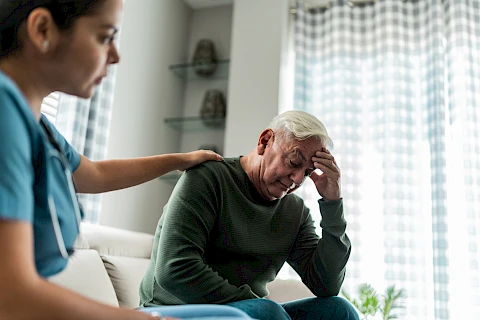
As the seasons change and daylight hours shorten, many people start to feel a shift in their mood and energy levels. In some cases, this can increase to a type of depression known as Seasonal Affective Disorder, or SAD. Understanding and recognizing SAD is crucial for caregivers, who may need to intervene or provide additional support for senior loved ones dealing with symptoms of SAD.
SAD in Seniors
Seasonal Affective Disorder is a form of depression that tends to occur during the fall and winter months when natural sunlight is reduced. SAD differs from general depression mainly in its seasonal nature. For seniors, who may already face a range of health challenges and changes in their social structure, SAD can exacerbate feelings of loneliness and apathy. Seniors are particularly vulnerable to SAD due to factors like limited mobility, the loss of friends or family, and a potential decrease in overall health.
Symptoms to Watch For
Recognizing the signs of SAD in seniors is the first step in providing effective support. Common symptoms include noticeable mood changes, such as feeling more depressed or anxious. Seniors may also experience fatigue and changes in their sleep patterns, like sleeping too much or struggling with insomnia. Another red flag is a withdrawal from social activities or a sudden disinterest in hobbies they once enjoyed. It's important to note that these symptoms can look different from those in younger people. In seniors, there might be more physical complaints and an increase in irritability.
Strategies for Support
Caregivers are essential in helping seniors with SAD. Establishing a consistent routine helps create stability and a sense of purpose. Encourage seniors to engage in daily activities, even if they are as simple as gardening or preparing a meal together. Physical activity is another cornerstone of support. It doesn't have to be intense—a daily walk or gentle exercise can work wonders. Finally, ensuring social interaction is essential. This could be through phone calls, social events, or even virtual meet-ups with family members.
Creating a Mood-Boosting Environment
One of the most effective ways to combat SAD is maximizing exposure to natural light. Open curtains and blinds during the day and position chairs to face windows. If natural light is limited, consider light therapy using a special lamp to mimic daylight. Indoors, encourage activities that promote mental well-being, like reading, puzzle-solving, or crafting. Nutrition also plays a vital role in mood regulation. A balanced diet rich in fruits, vegetables, and omega-3 fatty acids can improve overall health and help manage SAD symptoms.
When to Seek Professional Help
It's crucial to know when professional help is needed. If symptoms persist despite efforts to boost mood and activity levels, it might be time to consult a healthcare provider. Indicators for professional intervention include severe depression, significant weight loss or gain, and persistent insomnia. Treatment options available for SAD include therapy, such as cognitive-behavioral therapy, and medication. A healthcare provider can work with you to determine the best action.
In-Home Care for Seniors with SAD
Being proactive and vigilant as a caregiver is essential in managing the impacts of Seasonal Affective Disorder in seniors. Recognizing symptoms early, applying supportive strategies, and knowing when to seek professional help can have a meaningful impact. For caregivers in San Diego, Chula Vista, Hillcrest, and Point Loma, Senior Helpers San Diego is here to provide home care services that can help manage the symptoms of seasonal depression and improve quality of life. Reach out today to learn more.